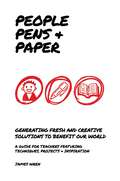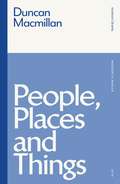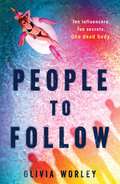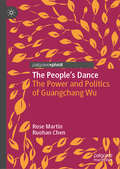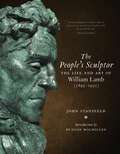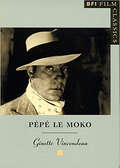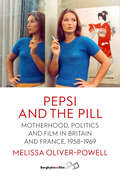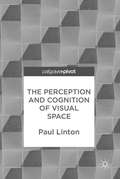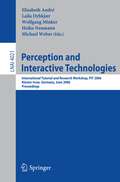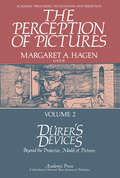- Table View
- List View
People in Watercolour (Collins 30-Minute Painting)
by Trevor WaughThis practical and inspirational guide, in a handy sketchbook format, is aimed at the practised beginner and shows how to achieve successful watercolour paintings of people in just 30 minutes – ideal for the busy amateur artist who doesn't have much time to paint.
A People Passing Rude: British Responses To Russian Culture
by Anthony CrossDescribed by the sixteenth-century English poet George Turbervile as "a people passing rude, to vices vile inclin’d", the Russians waited some three centuries before their subsequent cultural achievements—in music, art and particularly literature—achieved widespread recognition in Britain. The essays in this stimulating collection attest to the scope and variety of Russia’s influence on British culture. They move from the early nineteenth century—when Byron sent his hero Don Juan to meet Catherine the Great, and an English critic sought to come to terms with the challenge of Pushkin—to a series of Russian-themed exhibitions at venues including the Crystal Palace and Earls Court. The collection looks at British encounters with Russian music, the absorption with Dostoevskii and Chekhov, and finishes by shedding light on Britain’s engagement with Soviet film. Edited by Anthony Cross, one of the world’s foremost authorities on Anglo-Russian relations, A People Passing Rude is essential reading for anyone with an interest in British and Russian cultures and their complex relationship.
A People Passing Rude: British Responses to Russian Culture
by Anthony CrossDescribed by the sixteenth-century English poet George Turbervile as "a people passing rude, to vices vile inclin’d", the Russians waited some three centuries before their subsequent cultural achievements—in music, art and particularly literature—achieved widespread recognition in Britain. The essays in this stimulating collection attest to the scope and variety of Russia’s influence on British culture. They move from the early nineteenth century—when Byron sent his hero Don Juan to meet Catherine the Great, and an English critic sought to come to terms with the challenge of Pushkin—to a series of Russian-themed exhibitions at venues including the Crystal Palace and Earls Court. The collection looks at British encounters with Russian music, the absorption with Dostoevskii and Chekhov, and finishes by shedding light on Britain’s engagement with Soviet film. Edited by Anthony Cross, one of the world’s foremost authorities on Anglo-Russian relations, A People Passing Rude is essential reading for anyone with an interest in British and Russian cultures and their complex relationship.
People, Pens and Paper: Fresh Ideas for Schools to Teach the Creative Process
by James WrenPeople, Pens & Paper is about creative and fresh ideas. It's not a creative rule book, but a suggestive guide of techniques and projects to make the creative process more fluid and more enjoyable for students. Often, it's our setting and mindset that determines creative output, so in order to be truly effective we need to set the scene, and that also includes within ourselves. At this initial stage of the process all we need are paper, pens and people - we keep it organic and focus on generating solutions without any interference. With the projects featured, there's a focus on seeking out solutions for our planet rather than profit and commercialism. These ideas are recorded in a simple sketch book. This book can then help form a 'portfolio' of concepts for each student, so not only do the ideas look to help our world, they also show initiative and entrepreneurial flair, useful for life beyond school. From a marketing campaign for a local charity through to looking at ways to solve traffic issues at a school, teachers will be able to use innovative projects to inspire and also foster habitual ways to conceptualise, be it written or doodled.Readers will find no rules or quick-fixes.People, Pens & Paper is all about the process.
People, Personal Data and the Built Environment (Springer Series in Adaptive Environments)
by Holger Schnädelbach David KirkPersonal data is increasingly important in our lives. We use personal data to quantify our behaviour, through health apps or for 'personal branding' and we are also increasingly forced to part with our data to access services. With the proliferation of embedded sensors, the built environment is playing a key role in this developing use of data, even though this remains relatively hidden. Buildings are sites for the capture of personal data. This data is used to adapt buildings to people's behaviour, and increasingly, organisations use this data to understand how buildings are occupied and how communities develop within them. A whole host of technical, practical, social and ethical challenges emerge from this still developing area across interior, architectural and urban design, and many open questions remain.This book makes a contribution to this on-going discourse by bringing together a community of researchers interested in personal informatics and the design of interactive buildings and environments. The book’s aim is to foster critical discussion about the future role of personal data in interactions with the built environment.People, Personal Data and the Built Environment is ideal for researchers and practitioners interested in Architecture, Computer Science and Human Building Interaction.
People, Places and Things (Modern Classics)
by Duncan Macmillan"Macmillan doesn't shy away from difficult questions about addiction and recovery and, rightly, doesn't answer them ... this is a bold, timely and searching play" - Financial TimesEmma was having the time of her life. Now she's in rehab. Her first step is to admit that she has a problem. But the problem isn't with Emma, it's with everything else. She needs to tell the truth. But she's smart enough to know that there's no such thing. When intoxication feels like the only way to survive the modern world, how can she ever sober up?People, Places & Things premiered at the National Theatre in 2015 before transferring to London's West End and St. Ann's Warehouse in New York.Published for the first time in Methuen Drama's Modern Classics series, this edition features a brand new introduction by Naomi Obeng.
People, Places and Things (Modern Classics)
by Duncan Macmillan"Macmillan doesn't shy away from difficult questions about addiction and recovery and, rightly, doesn't answer them ... this is a bold, timely and searching play" - Financial TimesEmma was having the time of her life. Now she's in rehab. Her first step is to admit that she has a problem. But the problem isn't with Emma, it's with everything else. She needs to tell the truth. But she's smart enough to know that there's no such thing. When intoxication feels like the only way to survive the modern world, how can she ever sober up?People, Places & Things premiered at the National Theatre in 2015 before transferring to London's West End and St. Ann's Warehouse in New York.Published for the first time in Methuen Drama's Modern Classics series, this edition features a brand new introduction by Naomi Obeng.
People to Follow: A Gripping Social-Media Thriller
by Olivia WorleyTen influencers. Ten secrets. One dead body. A pacy, page-turning thriller perfect for fans of We Were Liars, The Inheritance Games and One Of Us Is Lying.'Agatha Christie meets TikTok . . . a wicked, juicy page-turner' - Alexa Donne, author of Brightly BurningThey're used to being followed. But not like this . . . Ten social media stars think they're about to join the cast of a hot new reality show. But the production crew never shows up, and the influencers find themselves stranded on a deserted Caribbean island with no contact with the outside world - except for messages from the mysterious 'Sponsor', who is threatening to expose their darkest secrets. When one of them winds up dead, things start to get more real than they bargained for . . .With the body count rising, the influencers must figure out who is trying to get them cancelled - like, literally - before their number one follower strikes again.
The People’s Dance: The Power and Politics of Guangchang Wu (Critical Studies in Dance Leadership and Inclusion)
by Rose Martin Ruohan ChenThis book presents an analysis of how the grassroots movement of Guangchang Wu or ‘square dance’ in China has become a national phenomenon. Through oral narratives offering rich descriptions of lived encounters, the experiences of those involved in leading, organizing, teaching and learning Guangchang Wu are revealed. Through these narratives, this book serves to understand the leadership practices occurring and how this dance practice is deeply rooted in the complexities of China’s rapid economic development, acceleration of urbanisation, and the desire for a healthier and more communal lifestyle.
The People's Sculptor: The Life and Art of William Lamb
by John StansfeldTracing the life and work the life of Scottish sculptor William Lamb (1893 - 1951) this is a story of indomitable will and irrepressible creativity. The son of an alcoholic father and a survivor of the 'lost generation' who came of age in 1914, it was with courage and determination that Lamb overcame the obstacles life put in his path. Traumatised in the trenches at Passchendaele during the First World War and blighted by depression, Lamb was also severely wounded in his right hand. With characteristic resolve he retrained with his left hand - at Edinburgh College of Art and the Ecole des Beaux Arts in Paris. Despite the uncertainty of an art market rocked by world war, Lamb established his reputation in Montrose with sculptures of the townspeople and fishermen of east Scotland. He produced prints, water colours and drawings to help fund his sculpture. Occasionally he undertook commissions and in 1932 he completed portrait bronzes of the young Princesses Elizabeth and Margaret. The Second World War dried up his supplies of materials, so he turned to wood carving and, when death finally put an end to his creativity, he left a large collection of his artwork as a legacy to the Scottish people.
The People's Stage in Imperial Germany: Social Democracy and Culture 1890-1914
by Andrew BonnellThis book examines the history of the Freie Volksbuhne (Free People's Theatre), Berlin, from 1890-1914, in the light of the cultural theory and practice of German Social Democracy in Imperial Germany.The clash between German Social Democracy – the party, intellectuals and workers – and the German Imperial State was played out in the Freie Volksbahne (Free People's Theatre) founded by intellectuals to energize working class political awareness of drama with a political and social cutting edge. It fell foul of state censorship, lost its bite, yet prospered.The book looks in detail at the various programmes guiding the Volksbuhne's work and at the reception of the plays by the largely working-class audience, to offer a detailed study of the interactions between cultural and political history in Imperial Germany.
Pepe le Moko (BFI Film Classics)
by Ginette VincendeauVincendeau's analysis places 'Pepe le Moko' in its aesthetic, generic and cultural contexts, ranging from Duvivier's brilliant camera-work, to Gabin's suits and the film's orientalist setting. In the BFI FILM CLASSICS series.
Pepe le Moko (BFI Film Classics)
by Ginette VincendeauVincendeau's analysis places 'Pepe le Moko' in its aesthetic, generic and cultural contexts, ranging from Duvivier's brilliant camera-work, to Gabin's suits and the film's orientalist setting. In the BFI FILM CLASSICS series.
Pepsi and the Pill: Motherhood, Politics and Film in Britain and France, 1958–1969
by Melissa Oliver-PowellThe 1960s was a decade of massive political and cultural change in Western Europe, as seismic shifts took place in in attitudes towards sexuality, gender, and motherhood in everyday life. Through case studies of British and French films, Pepsi and the Pill offers a fresh vision of a pivotal moment in European culture, exploring the many ways in which political activity and celebrated film movements mutually shaped each other in their views on gender, sexuality, and domesticity. As the specter of popular nationalism once again looms across Europe, this book offers a timely account of the legacy of crucial debates over issues including reproductive rights, migration, and reproductive nationalism at the intersection of political discourse, protest, and film.
Pepsi and the Pill: Motherhood, Politics and Film in Britain and France, 1958–1969
by Melissa Oliver-PowellThe 1960s was a decade of massive political and cultural change in Western Europe, as seismic shifts took place in in attitudes towards sexuality, gender, and motherhood in everyday life. Through case studies of British and French films, Pepsi and the Pill offers a fresh vision of a pivotal moment in European culture, exploring the many ways in which political activity and celebrated film movements mutually shaped each other in their views on gender, sexuality, and domesticity. As the specter of popular nationalism once again looms across Europe, this book offers a timely account of the legacy of crucial debates over issues including reproductive rights, migration, and reproductive nationalism at the intersection of political discourse, protest, and film.
Perception and Agency in Shared Spaces of Contemporary Art (Routledge Advances in Art and Visual Studies)
by Cristina Albu Dawna SchuldThis book examines the interconnections between art, phenomenology, and cognitive studies. Contributors question the binary oppositions generally drawn between visuality and agency, sensing and thinking, phenomenal art and politics, phenomenology and structuralism, and subjective involvement and social belonging. Instead, they foreground the many ways that artists ask us to consider how we sense, think, and act in relation to a work of art.
Perception and Agency in Shared Spaces of Contemporary Art (Routledge Advances in Art and Visual Studies)
by Cristina Albu Dawna SchuldThis book examines the interconnections between art, phenomenology, and cognitive studies. Contributors question the binary oppositions generally drawn between visuality and agency, sensing and thinking, phenomenal art and politics, phenomenology and structuralism, and subjective involvement and social belonging. Instead, they foreground the many ways that artists ask us to consider how we sense, think, and act in relation to a work of art.
The Perception and Cognition of Visual Space
by Paul LintonThis book explores a central question in the study of depth perception - 'does the visual system rely upon objective knowledge and subjective meaning to specify visual depth?' Linton advances an alternative interpretation to the generally accepted affirmative answer, according to which many of the apparent contributions of knowledge and meaning to depth perception are better understood as contributions to our post-perceptual cognition of depth. In order to defend this position a new account of visual cognition is required, as well as a better understanding of the optical and physiological cues to depth. This book will appeal to students and researchers in psychology, vision science, and philosophy, as well as technologists and content creators working in virtual and augmented reality.
The Perception and Cognition of Visual Space
by Paul LintonThis book explores a central question in the study of depth perception - 'does the visual system rely upon objective knowledge and subjective meaning to specify visual depth?' Linton advances an alternative interpretation to the generally accepted affirmative answer, according to which many of the apparent contributions of knowledge and meaning to depth perception are better understood as contributions to our post-perceptual cognition of depth. In order to defend this position a new account of visual cognition is required, as well as a better understanding of the optical and physiological cues to depth. This book will appeal to students and researchers in psychology, vision science, and philosophy, as well as technologists and content creators working in virtual and augmented reality.
Perception and Imaging: Photography as a Way of Seeing
by John Suler Richard D. ZakiaWhen you look at an image, what do you see and feel? What do you want your audience to see and feel when they view your work? For over thirty years, Dr. Richard Zakia helped thousands of photographers hone in on their creative vision through the inspirational, informative text and images included in his classic book, Perception and Imaging. More than a step-by-step photography instruction manual, Perception and Imaging explores the fundamental act of photography – seeing – through a uniquely comprehensive combination of technique, history, visual perception, philosophy and psychology. No matter your level of technical skill, you can learn to think more clearly about what you wish to convey in your images. Fully revised to account for the unique influences and consequences of the digital revolution and online photosharing, John Suler newly addresses digital impermanence, sensory and cognitive overload, and the selfie, and their effects on perception. Additional coverage also includes microexpressions, Rorschach inkblots and subliminal reactions, transference, and synectics.
Perception and Imaging: Photography as a Way of Seeing
by John Suler Richard D. ZakiaWhen you look at an image, what do you see and feel? What do you want your audience to see and feel when they view your work? For over thirty years, Dr. Richard Zakia helped thousands of photographers hone in on their creative vision through the inspirational, informative text and images included in his classic book, Perception and Imaging. More than a step-by-step photography instruction manual, Perception and Imaging explores the fundamental act of photography – seeing – through a uniquely comprehensive combination of technique, history, visual perception, philosophy and psychology. No matter your level of technical skill, you can learn to think more clearly about what you wish to convey in your images. Fully revised to account for the unique influences and consequences of the digital revolution and online photosharing, John Suler newly addresses digital impermanence, sensory and cognitive overload, and the selfie, and their effects on perception. Additional coverage also includes microexpressions, Rorschach inkblots and subliminal reactions, transference, and synectics.
Perception and Interactive Technologies: International Tutorial and Research Workshop, Kloster Irsee, PIT 2006, Germany, June 19-21, 2006 (Lecture Notes in Computer Science #4021)
by Wolfgang Minker Heiko Neumann Michael Weber Elisabeth André Laila DybkjærThis book constitutes the refereed proceedings of the International Tutorial and Research Workshop on Perception and Interactive Technologies, PIT 2006, held at Kloster Irsee, Germany, June 2006. The book presents 16 revised full papers together with 4 revised poster papers and 6 system demonstration papers, organized in topical sections on head pose and eye gaze tracking, modeling and simulation of perception, integrating information from multiple channels, and more.
Perception, Design and Ecology of the Built Environment: A Focus on the Global South (Springer Geography)
by Mainak GhoshThis edited volume is a compilation of the ‘built environment’ in response to many investigations, analyses and sometimes mere observations of the various dialogues and interactions of the built, in context to its ecology, perception and design. The chapters concentrate on various independent issues, integrated as a holistic approach, both in terms of theoretical perspectives and practical approaches, predominantly focusing on the Global South. The book builds fabric knitting into the generic understanding of environment, perception and design encompassing ‘different’ attitudes and inspirations. This book is an important reference to topics concerning urbanism, urban developments and physical growth, and highlights new methodologies and practices. The book presumes an understanding unearthed from various dimensions and again woven back to a common theme, which emerges as the reader reads through.Various international experts of the respective fields working on the Global South contributed their latest research and insights to the different parts of the book. This trans-disciplinary volume appeals to scientists, students and professionals in the fields of architecture, geography, planning, environmental sciences and many more.
Perception in Multimodal Dialogue Systems: 4th IEEE Tutorial and Research Workshop on Perception and Interactive Technologies for Speech-Based Systems, PIT 2008, Kloster Irsee, Germany, June 16-18, 2008, Proceedings (Lecture Notes in Computer Science #5078)
by Elisabeth André Laila Dybkjær Heiko Neumann Roberto Pieraccini Michael WeberThis book constitutes the refereed proceedings of the 4th IEEE Tutorial and Research Workshop on Perception and Interactive Technologies for Speech-Based Systems, PIT 2008, held in Kloster Irsee, Germany, in June 2008. The 37 revised full papers presented together with 1 invited keynote lecture were carefully selected from numerous submissions for inclusion in the book. The papers are organized in topical sections on multimodal and spoken dialogue systems, classification of dialogue acts and sound, recognition of eye gaze, head poses, mimics and speech as well as combinations of modalities, vocal emotion recognition, human-like and social dialogue systems, and evaluation methods for multimodal dialogue systems.
The Perception of Pictures: Dürer's Devices: Beyond the Projective Model of Pictures
by Margaret A. HagenDurer's Devices: Beyond the Projective Model of Pictures is a collection of papers that discusses the nature of picture making and perception. One paper presents a perceptual theory of pictorial representation in which cultural and historical options in styles of depiction that appear to be different are actually closely related perceptually. Another paper discusses pictorial functions and perceptual structures including pictorial representation, perceptual theory, flat canvass, and the deep world. One paper suggests that perception can be more a matter of information "make up" than "pick up." Light becomes somewhat informative and the eye, correspondingly, becomes less or more presumptive. Another paper notes that human vision is transformed by our modes of representation, that image formation can be essentially incomplete, false, or misleading (primarily as regards dramatic performance and pictorial representation). One paper makes three claims that: (1) the blind have untapped depiction abilities; (2) haptics, involving the sense of touch, have an intuitive sense of perspective; and (3) depiction is perceptual based on graphic elements and pictorial configurations. The collection is suitable for psychologists, physiologists, psychophysicists, and researchers in human perception or phenomenology.


